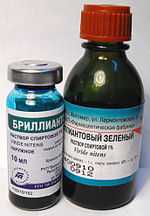Brilliant Green (dye)
| Brilliant Green (dye) | |
|---|---|
 | |
| Other names Malachite green G, Emerald green, Solid green JJO, Diamond green G, Aniline green, Benzaldehyde green, Fast green J | |
| Identifiers | |
| CAS number | 633-03-4 |
| PubChem | 12449 |
| ChemSpider | 11941 |
| UNII | G0L543D370 |
| ChEMBL | CHEMBL1181633 |
| Jmol-3D images | {{#if:[O-]S(=O)(=O)O.[N+](=C/1\C=C/C(C=C\1)=C(/c2ccccc2)c3ccc(N(CC)CC)cc3)(\CC)CC|Image 1 |
| |
| |
| Properties | |
| Molecular formula | C27H33N2.HO4S |
| Molar mass | 482,64 g/mol |
| Melting point | 210 °C (decomposes) |
| Solubility in water | 100 g/L a 20 °C |
| Except where noted otherwise, data are given for materials in their standard state (at 25 °C (77 °F), 100 kPa) | |
| Infobox references | |
Brilliant Green is one of the triarylmethane dyes. It is closely related to malachite green.[1]
Uses

Brilliant Green has been used to color silk and wool.
In Eastern Europe and Russia (and formerly the USSR) the dilute alcoholic solution of Brilliant Green is sold as a topical antiseptic, also known under a Latin name Viridis nitentis spirituosa and a Russian colloquial name зелёнка [zelyonka].[2]
Brilliant Green is effective against gram-positive bacteria. The main advantage of Brilliant Green over the more common antiseptics such as iodine is that it does not irritate mucous membranes. Therefore it is often used to treat infections of the eye, tongue sores and sinus infections. Brilliant green induces vomiting when swallowed and is toxic when ingested.[3]
References
- ↑ Gessner, T.; Mayer, U. (2002), "Triarylmethane and Diarylmethane Dyes", Ullmann's Encyclopedia of Industrial Chemistry 6th Edition, Weinheim: Wiley-VCH, doi:10.1002/14356007.a27_179
- ↑ M. Balabanova, L. Popova, R. Tchipeva, Disease-a-Month, 50(6), 2004, 270-279. link
- ↑ Joseph K. Narat, Brilliant Green: A Clinical Study of its Value as a Local Antiseptic" Annals of Surgery 1931 December; 94(6): 1007–1012. BRILLIANT GREEN
Other reading
- FICHA DE SEGURANÇA - Verde brilhante (in Portuguese)